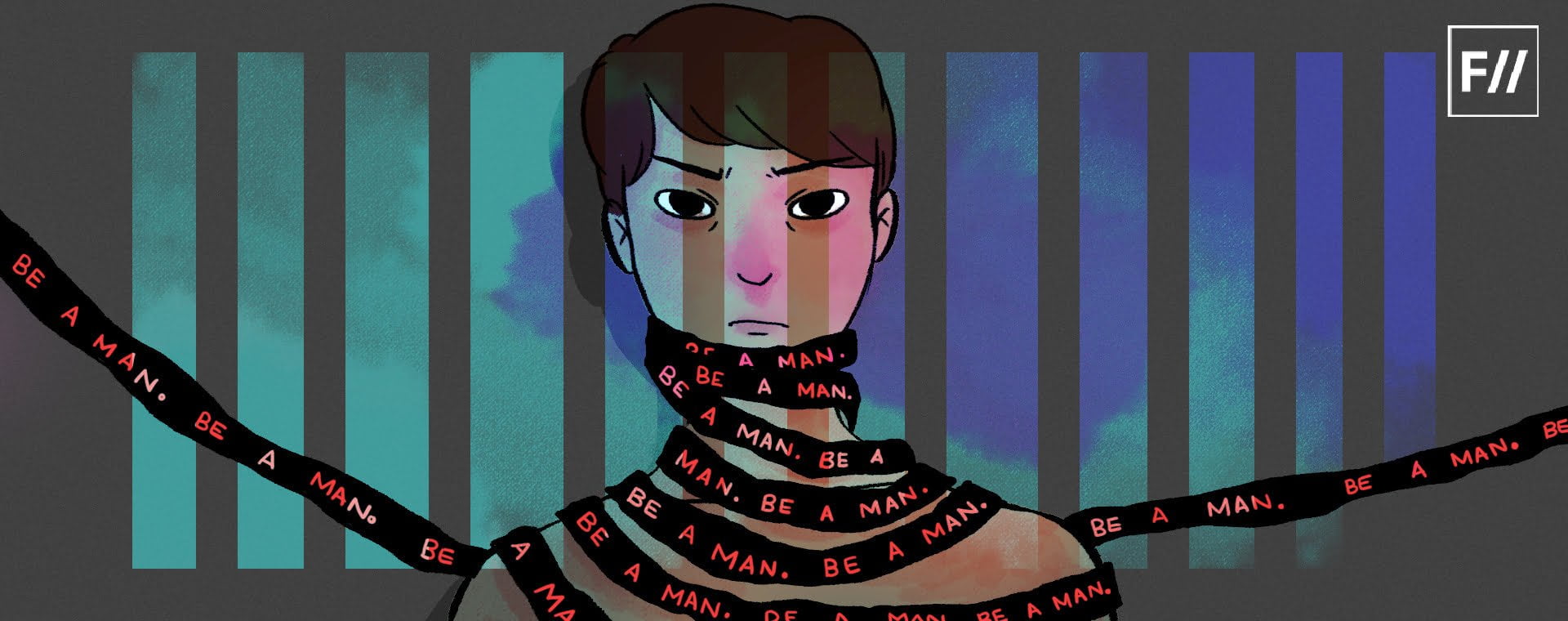When the I Need Feminism campaign was started by the Feminism in India, after successful similar endeavours at the Oxford and Cambridge universities, social media got flooded with images of men and women holding placards that shout out their need to support feminism. Every placard had the common clause “I need feminism because…” which later became the hashtag for the campaign too. What struck me as both delightful and disturbing is the strong presence of a substantial number of men in the campaign which naturally opens up the question related to men’s position in feminism. The very obvious question that might be thrown on my face, right at this moment, by gender and masculinity studies scholars, as well as other men and women, is that – can men not be feminists? Is feminism biologically determined? Am I still latching on to a structuralist position that predicates itself on a binarised gender role? While all these questions are extremely relevant and deserves answering multiple times, I would request my readers to reserve their knee-jerk and allow me to vindicate my position!
While Masculinity Studies emerged as an academic discipline much recently (as a counterpart to Women’s studies and Feminist studies); a careful observation will reveal that urban, middle class men in India started engaging themselves with gender causes (women’s causes to be precise) only post December 16, 2012. However, this is not to say that men in India were oblivious to gender causes prior to that chronological marker; men’s activism and fight for gender equality can be traced back to the pre-independence days to Ram Mohan Roy and Vidyasagar (although a problematic engagement, I must admit) to Jyotirao Phule and Ambedkar with his insistence on women’s right to inheritance. While the big boys can be located in the legacy of the feminist movement in India, it is only recently, post 16th December 2012 that we witness a popular turn in feminism. I employ ‘popular’ in its dual sense here: both favoured, largely admired and well liked; and also that of the masses, the populace, related to the amateur. This massification of ‘feminism’ accounts for so many women and men (in mea culpa mode) joining the struggle; taking it forward and branching it out in so many directions that ‘feminism’ has become the latest buzzword. It is in vogue to be a feminist now; a fashion, a style statement; either you succumb to the peer pressure or be ready to be labelled ‘regressive’.
The contentious question that remains, then, is that, in such an overwhelming ‘feminist oeuvre’ where do men stand in relation to feminism? While on one hand there are demands for castration and death penalty for rapists; on the other, a steady rise in the number of men-led campaigns like MARD (Men Against Rape & Discrimination); the Indian man finds himself enmeshed in an ambivalent subject position, caught between tradition and modernity. While men’s participation in the feminist movement necessarily entails the risk of behalfism, in a poststructural, deconstructivist setting their significance cannot be shunned either. The Indian subcontinent is now witnessing more men entering into the battle for gender equality, breaking taboos related to women and against the policing of the moral rightists. From campaigns against Love Jihad, to the Kiss of Love movement, to the Shuddh Desi Romance protest in front of the Hindu Mahasabha office on Valentine’s day, to the Pads Against Sexism campaign in Jamia Milia Islamia University and Delhi University respectively and several others against sexual violence, witnessed the participation of men in great numbers. What is thought-provoking and concerning for some of us, now, is what does this great influx of men in feminism or feminist struggles mean politically? What political imagination marks the entry of men into feminism?
Men’s relation to and position in feminism seems to be fraught with elements of privileges based on gender, class, caste, race et al. There can be two principally opposing views regarding men’s relation to feminism. Stephen Heath argues that “men’s relation to feminism is an impossible one” and makes it clear in his subsequent argument that this ‘impossibility’ has a political edge to it. This ‘impossibility’ is grounded on the fact, that, it entails the risk of dominating and appropriating narratives of marginalization; in this case, invisibilization of women and queer voices. Men allying with feminism and expressing solidarity, supporting, practicing and participating in feminist struggles seems to be a paradoxical and irreconcilable notion in this regard. Heath further argues, that, “I am not where they are and that I cannot pretend to be (though men do, colonizing, as they always have done) which is the impossibility of my, men’s relation.” This apparent contradictory subject-position of being a male-feminist is overturned by Bell Hooks who envisions men as comrades in her struggle for gender egalitarianism. Hooks argues, “men who actively struggle against sexism have a place in feminist movement. They are our comrades. Feminists have recognized and supported the work of men who take responsibility for sexist oppression…” The feminist camp, therefore, maintains a problematic relationship with regard to men’s relationship to feminism.
It is interesting and worth noting at this point, that, the ‘impossibility’ which Heath mentions in his argument seems to be aporetic; impossibility, here, is not an end in itself. Heath does not shun the possibility of men engaging themselves with feminism; ‘impossibility’ is a deferred possibility, of the future, that is yet to come – a postponed Derridean moment in time when men shall not only learn of their privileges but also learn to unlearn them, negate them, annihilate their superior subject-position to be comrades and allies with women and queers in their battle for equality. That patriarchy hurts men too; that men feel oppressed because they cannot cry in public, cannot express their feelings or emotions; that there are subordinate and marginalized masculinities; are part of a tired and worn out rhetoric. None of these entails giving up on or overlooking the multiple male privileges that one enjoys by the virtue of being a man (cisgender or otherwise). Therefore, when we deliberate on the idea of men entering into feminism, we need to pause and interrogate as to what are they entering from and what are they entering into? What is the subject-position that precedes and succeeds the entry? Our engagement with feminism can only be possible once we disengage with all those patriarchal rewards that masculinity reaps; but then again, disengagement or unlearning male-privilege is not an end in itself; it must be a continuum lest the subject-position gets consolidated and generates further privileges.
So much of contention and fissure as to men’s relationship with feminism then opens up the larger question related to authenticity; as to who represents the feminist movement? That patriarchy is not biologically determined and so neither is feminism overstated; what we need to ponder on is the impossibility of a pure political subject (that is, if we consider feminism as a political field of action) implicated in a certain ideology or philosophy. Also, we need to take note alongside that patriarchy never functions in isolation; and the more we are moving towards a post-patriarchal temporality, patriarchy guises itself under the registers of class, race, caste and so on. Patriarchal-capitalism functions very differently from patriarchal-racism or dalit-patriarchy; there is no one, monolithic patriarchy; there are patriarchies. And to resist the hegemonizing impulses of such patriarchies that can emerge in multiple forms in unexpected ways from unexpected quarters, solidarities can be sought from across affective communities, across the registers of gender, race, sexual orientation or preference. Men, women, and people of all genders can negotiate with their subject-position; learn to unlearn their privileges and participate in the feminist struggle towards egalitarianism.
It would be apt to conclude with Spivak’s interrogation – “how feminist am I in my salaried work, how engaged, how intellectual? It seems to me that our first instance of engagement is in how we have chosen to support ourselves, even if unwillingly, because with that support we think we can be engaged feminist intellectuals outside.” We have to be persistent in our evaluation and critical awareness of that ‘support’; the ‘support’ that makes us feminist; the ‘support’ that enables us to enter into the field of radical resistance and to de-center masculinity to create a politics of fissure and interruption in the patriarchal, hetero/homo-normative distribution of the sensible.
References
1. Heath, Stephen. “Male Feminism.” Men in Feminism. New York: Routledge, 1987. Print.
2. Hooks, Bell. Feminist Theory: From Margin to Center. South End, 1984. Print.
3. Spivak, Gayatri Chakravorty. “The Engaged Feminist Intellectual.” Columbia University, Lecture.
Featured Image Credit: respectwomen.co.in



